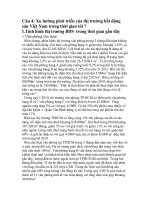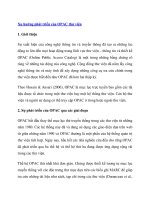du lịch sinh thái neu xu hướng phát triển của du lịch và lịch sử phát triển của du lịch sinh thái
Bạn đang xem bản rút gọn của tài liệu. Xem và tải ngay bản đầy đủ của tài liệu tại đây (356.79 KB, 73 trang )
n
ng
i – Ecotourism
nh
ng 8/2011
CuuDuongThanCong.com
/>
CHƢƠNG 1
XU HƢỚNG PHÁT TRIỂN CỦA DU LỊCH VÀ
LỊCH SỬ PHÁT TRIỂN CỦA DU LỊCH SINH THÁI
Mục tiêu của chƣơng :
Sau khi học xong chƣơng này sinh có khả năng :
• Nắm bắt được xu hướng phát tiển mới trong du lịch
• Hiểu được lịch sử phát triển của du lịch sinh thái
• Hiểu được ý nghĩa của phát triển du lịch sinh thái đối với
phát triển bền vững
Nội dung của chƣơng :
• 1.1 Xu hướng phát triển mới trong du lịch
• 1.2 Lịch sử phát triển của Du lịch sinh thái (DLST) và
mối quan hệ giữa DLST với những thay đổi mơi trường
tồn cầu
CuuDuongThanCong.com
/>
Xu hƣớng phát triển mới trong
du lịch
Vai trò của du lịch đối với nền kinh tế mỗi quốc gia
và trên toàn thế giới
–
-
i.
(
-
CuuDuongThanCong.com
nh Dương).
/>
–
n
nay.
CuuDuongThanCong.com
/>
The sector now becomes the world largest industry in
terms of number of people participating, the employment
capacity, and the amount of resources generated.
According the London tourism Minister‟s Summit
(November 2008),each year:
• Tourism generated 230 millions jobs- 10 percent of all
jobs globally- and is one of the top five sources of foreign
currency for 83 percent of developing countries.
• Tourism is expected to draw 1.6 billions international
travelers in 2020 (UNWTO‟s tourism 2020 vision). This
sector has only recently grown in size, due to a
combination of historical circumstances.
CuuDuongThanCong.com
/>
• Raising affluence in the industrialized
countries, coupled with International Labor
Organization (ILO)-mandated leisure time
and paid vacations, also contributed
significantly towards making mass
tourism (or conventional tourism).
[1] affordable for many (McLaren 2003).
CuuDuongThanCong.com
/>
n 2030
c
t tay )
CuuDuongThanCong.com
/>
From “mass tourism” to “alternative
tourism”:
The first is “Mass Tourism (MT)”, which has prevailed on
the market for some time. The second broad category
(AT) is that of alternative tourism, a flexible generic
category that contains a multiplicity of various forms that
have one feature in common- they are alternatives to
(MT). AT is a generic term that encompasses a whole
range of tourism strategies (e.g. “appropriate”, “eco”,
“soft”, “responsible”, “small scale”, “green” tourism). That
is, they are not associated with mass large scale tourism
but are essentially small scale.
CuuDuongThanCong.com
/>
where MT leads to the homogenization of
the tourism product, AT promotes
„desirable differences‟ between
destinations and also what Relph (1976)
calls the „sense of place‟ (Travis, 1982);
where MT is „externally controlled‟, AT is
„locally controlled‟; where MT is „highimpact‟, AT is „low impact‟, etc.
CuuDuongThanCong.com
/>
Although (MT) may be said to be predominantly unsustainable, but more recently
Unsustainable practice
Sustainable practice
MASS TOURISM
ALTERNATIVE TOURISM
Socio-cultural tourism
Cultural tourism
Agri-tourism
Nature based tourism
NBT
Non Consumptive
Consumptive
NBT
NBT
Ecotourism
(Passive)
CuuDuongThanCong.com
Adventure
tourism
(Active)
/>
Xu hướng mới của DL có trách
nhiệm
•
•
Du lịch đại trà (mass tourism) khơng cịn chiếm được vị trí hồng
kim như những năm 60s, 70s và 80s.
Thay vào đó là những loại hình du lịch mới (alternative tourism)
như du lịch văn hóa, du lịch mang tính giáo dục, du lịch khoa học
nghiên cứu, du lịch mạo hiểm, du lịch nông thôn trang trại với
nhiều ưu điểm hơn. Những loại hình này vừa đảm bảo sự thỏa
mãn khách du lịch (khám phá, hưởng thụ, học hỏi), vừa mang lại
lợi ích cho cộng đồng dân cư địa phương (nâng cao thu nhập, cải
thiện đời sống vật chất), vừa khuyến khích các nhà kinh doanh du
lịch đầu tư dài hạn (đảm bảo quyền lợi nhà kinh doanh bằng việc
sự dụng lao động địa phương), và vừa bảo vệ môi trường (thông
qua giáo dục, lập quỹ bảo tồn).
CuuDuongThanCong.com
/>
Dernoi (1981) illustrate that the advantages of AT
will be felt in five ways:
• 1. There will be benefits for the individual or
family: accommodation based in local homes will
channel revenue directly to families. Also
families will acquire managerial skills.
• 2. The local community will benefit: AT will
generate direct revenue for community
members, in addition to upgrading housing
standards while avoiding huge public
infrastructure expenses.
CuuDuongThanCong.com
/>
• 3. For the host country, AT will help avoid the
leakage of tourism revenue outside the country.
AT will also help prevent social tensions and
may local traditions.
• 4. For those in the industrialised generating
country, AT is ideal for cost-conscious travellers
or for people who prefer close contacts with
locals.
• 5. There will be benefits for international
relations: AT may promote internationalinterregional-intercultural understanding
CuuDuongThanCong.com
/>
Potential benefits derived from an Alternative Tourism
strategy. (Weaver 1993 In: Fennell David A. (1999),
“Ecotourism: an introduction”.
Accommodation
•
Does not overwhelm the community.
•
Benefits (jobs, expenditures) are more evenly
distributed.
•
Less competition with homes and businesses for
the use of infrastructure.
•
A larger percentage of revenues accrue to local
areas.
•
Greater opportunity for local entrepreneurs to
participate in the tourism sector
CuuDuongThanCong.com
/>
Attractions
•
community is promoted and enhanced.
•
Attractions are educated and promote self-fulfilment.
•
ng)
t) of
Market
•
Tourists do not overwhelm locals in numbers, stress is avoided.
•
ch )
•
A more desirable visitor type.
•
ng )
within a single major market.
CuuDuongThanCong.com
/>
Economic impacts
•
ng) is promoted to
avoid single-sector dependence.
•
) each other.
•
nh ) within the community.
• More jobs and economic activity are
generated.
CuuDuongThanCong.com
/>
Regulation
•
Community makes the critical development/strategy
decisions.
•
Planning to meet ecological, social, and economic
carrying capacities.
•
Holistic approach stresses integration and well-being
of community interests.
•
Long-term approach takes into account the welfare of
future generations.
•
Integrity of foundation assets is protected.
•
ng ) is
reduced
CuuDuongThanCong.com
/>
The (AT) is shown to comprise different
types of tourism. As to the specific forms
of AT, AT is considered in two categories:
socio-cultural tourism and naturebased tourism.
CuuDuongThanCong.com
/>
1- Socio-cultural tourism includes cultural
tourism, and agri-tourism.
• “Cultural tourism” (or culture tourism) is the
subset of Alternative Tourism concerned with a
country or region's culture, especially its arts.
Cultural tourism includes tourism in urban areas,
particularly historic or large cities and their
cultural facilities such as museums and theatres.
It can also include tourism in rural areas
showcasing the traditions of indigenous cultural
communities (i.e. festivals, rituals), and their
values and lifestyle.
CuuDuongThanCong.com
/>
• Cultural tourism has been defined as “the
movement of persons to cultural
attractions away from their normal
place of residence, with the
intention to gather new information
and experiences to satisfy their
cultural needs”.
CuuDuongThanCong.com
/>
• Agritourism is a style of vacation that
normally takes place on a farm
i
or ranch
t . This may
include the chance to help with farming
and ranching tasks during the visit.
Agritourism is considered to be a niche or
uniquely adapted form of tourism and is
often practiced in agriculture growing
regions.
CuuDuongThanCong.com
/>
The reasons for popularity of Agritourism is that
people are more interested in how their food is
produced and want to meet the producers and
talk with them about what goes into food
production. Children who visit the farms often
have not seen a live duck, or pig, and have not
picked an apple right off the tree. This form of
expanded agri-tourism has given birth to what
are often called "entertainment farms."
CuuDuongThanCong.com
/>
• non consumptive:the non consumptive use
activities are those in which the organism is not
affected by human interaction (e.g.
Birdwatching, nature walks and natural
photography).
• consumptive : Contrariwise, consumptive use
activities impose certain purposefully intended
impacts on the organism such as forms of
hunting, fishing, and specimen collection (eg.
butterflies) must be controlled if it is not to
destroy the natural resources on which tourism
depends.
CuuDuongThanCong.com
/>
• Nature-based tourism includes
Ecotourism and adventure tourism.
Nature-based tourism is tourism which
utilizes nature in all its diversity for a wide
range of recreational and leisure activities,
Nature-based tourism, according to the
World Resources Institute, is growing by
up 4% (Lindberg, 1991).
CuuDuongThanCong.com
/>
• Many authors use the term “nature based
tourism” and “ecotourism”
interchangeably, such as Lindberg (1991)
and McNeely et al. (1992), while some
limit it to tourism based primarily on living
natural things. It is difficult to draw a clear
cut line between ecotourism and nature
tourism because of the fuzziness in
judging whether a tourism activity is
environmentally consumptive or not.
CuuDuongThanCong.com
/>









